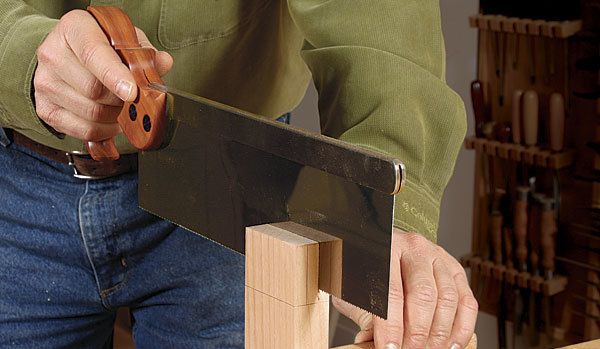Tool Test: Backsaws that Can Do It All
The versatile carcase saw will cut most joinery—our expert picks the best of a bumper crop
Synopsis: The first saw most woodworkers should get is a carcase saw. With a 12-in.-long blade that has 2 in. or more of cutting depth, the saw is big enough to cut carcase dovetails, tenons for door frame rails and table aprons, yet small enough for drawer dovetails. It doesn’t matter if the teeth are filed for a ripcut, crosscut, or somewhere between, as long as they are sharpened so that the saw cuts quickly and tracks straight. Chris Gochnour tested 18 carcase saws, for how quickly they cut, how easy they are to start, how effective they are at cutting joinery, and how well they track for ripcuts. All were good, but some stood out.
Dovetail saws are a popular choice for a first joinery saw, but because of the blade’s length and shallow depth, they are only suitable for cutting dovetails in thin parts like drawer sides. To cut carcase dovetails, and tenons for door frame rails and table aprons, you need a carcase saw. With a 12-in.-long blade that has 2 in. or more of cutting depth, the saw is big enough for these joints yet small enough for drawer dovetails. Because it’s so versatile, the carcase saw is what I recommend as a first saw to new woodworkers.
During the past 10 years, there has been an explosion of new saw makers and saws, and Fine Woodworking asked me to take a look at the carcase saws now available. A search turned up 18 saws. Except for one (the Lie-Nielsen tapered crosscut saw), they all have 12-in.-long saw plates, and between 11 and 15 points per inch (ppi). Although I prefer teeth filed for ripcuts, I tested saws filed for crosscuts, too. One saw, the Bad Axe hybrid, has teeth filed between rip and crosscut.
I tested how quickly they cut, and how easy they are to start. I used them to cut dovetails and tenons. I judged how well they track for ripcuts, but not crosscuts. With some ripcuts (such as the tail cuts for dovetails) a cut that goes awry can’t be corrected, but a wonky crosscut often can be fixed with a handplane. After decades of using handsaws, I’ve learned that a saw’s performance hinges on one thing: how well its teeth have been sharpened. Over all, these saws reinforced that lesson: The best performers had the best sharpening jobs. Although most hobbyist woodworkers won’t need to resharpen a saw very often (every few years at most), we identified in the chart makers who offer sharpening services (see pp. 36-37).
After weeks of using all these saws every which way, I realized that there are a lot of very good saws on the market. However, four were a bit better than the rest, and one was an exceptional value. Keep in mind that several makers are individuals who make each saw every step of the way. The nature of this work means that if you buy a saw from one of them, you might wait weeks or months before it’s in your hands. Their saws can often be customized, so for these makers, we’ve listed the saw’s minimum price. It could be higher depending on the options.
For the full article, download the PDF below:
Fine Woodworking Recommended Products

Olfa Knife

Bahco 6-Inch Card Scraper

Veritas Wheel Marking Gauge






















Log in or create an account to post a comment.
Sign up Log in